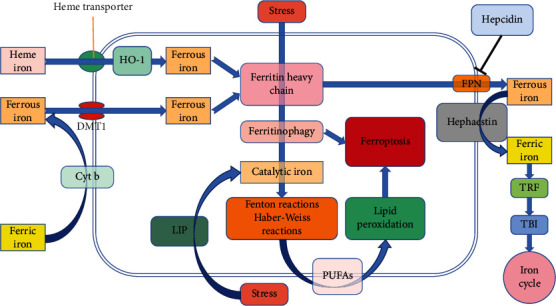Figure 3.

Partial cross-molecular mechanisms of iron metabolism and ferroptosis. Iron enters cells through different mechanisms: intracellular iron is either stored in Fth or regulated by FPN exocytosis into the plasma and oxidized to ferric iron, which then binds to TRF to start the iron cycle. The chelation of Fer to ferrous iron is limited. Under stress conditions, such as starvation and hypoxia, ferritinophagy is activated and catalytic iron is released in LIP. Catalytic iron can produce Fenton and Haber-Weiss reactions with ROS, affect the synthesis of PUFAs on the cytomembrane, and gradually induce lipid peroxidation and ferroptosis. Abbreviations: Cyt b: cytochrome b; DMT1: divalent metal transporter 1; HO-1: heme oxygenase-1; Fer: ferritin; Fth: ferritin heavy chain; LIP: labile iron pool; ROS: reactive oxygen species; PUFAs: polyunsaturated fatty acids; FPN: ferroportin; TRF: transferrin; TBI: transferrin binding iron.
